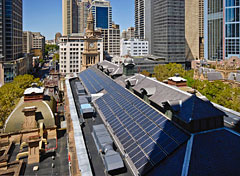The City of Sydney looks like it will claim the crown for the country’s largest rooftop PV installation, with a 1.25-megawatt (MW) installation edging out current record-holder University of Queensland’s 1.2-MW system by just 50 kilowatts (kW). Although questionable whether the arrays constitute a single monolithic ‘system’, the tender for the project encompasses greater nominal peak capacity than any other rooftop project in Australia.

The systems, whose installation will take place over the next 2 years, will be spread across 30 properties in the City of Sydney, such as Town Hall House, Glebe, Redfern and Paddington town halls, the Redfern Oval grandstand, Railway Square bus station, plus a number of libraries, council depots, and community centres within the CoS jurisdiction. The system will supply roughly 12.5% of the electrical power needs of city council properties, funded using the $2 million/year budget previously allocated to purchasing GreenPower, and will complement the existing solar PV on rooftops of 18 other city properties. The solar plans fall into the greater framework of the City of Sydney’s plans for 2030, which include producing enough power to meet local electricity needs by 2030, and reducing its greenhouse gas emissions by 50% by 2030 and 70% by 2050.
Sydney’s solar project is an indication of the growing viability of commercial-scale solar power in this Solar Feed-in Tariff-free environment. In combination with an effective regimen of energy saving, efficiency, and awareness amongst those who occupy the buildings daily, solar PV is an excellent tool for both saving money and reducing CO2 emissions.
Although the main purpose of the 1.25MW of forthcoming solar PV installations is to trumpet the council’s green ambitions, underlying this seems to be the business case for investing in solar PV vs GreenPower. Although in the short term, the price of producing solar power will be more expensive, the rising price of grid power means that producing solar power will likely be more cost-effective in the long-term, especially in light of the City’s localised power generation goals.
Further proof of its desire to stand out as a leader amongst Australia’s local councils in the field of greenhouse gas emissions abatement, Sydney has even chosen to forego the effective federal government subsidy that is usually afforded to renewable power generation systems through the Renewable Energy Target. The city chose to ‘retire’ the Renewable Energy Certificates (RECs) rather than sell them. This was done “so that the City’s efforts to reduce greenhouse gas emissions through renewable energy projects will go beyond the Federal Government’s Renewable Energy Target — increasing the amount of renewable energy generated in Australia,” according to a tender committee document.
The price tag for the project is $6 million, meaning that the overall cost per watt comes out $4.80, compared to a cost of between $2 and $3 watt for more competitive large-scale installations. In addition to the forfeited REC benefit, the cost difference can be further accounted for by considering the other factors involved. These include the broad, holistic, and community-focused nature of the city’s solar plans (and associated costs), the varied nature of the installations themselves (most are standard installs, but BIPV and solar electric vehicle charging points also appear in the list), as well as the top-end expertise and components that are to be employed.